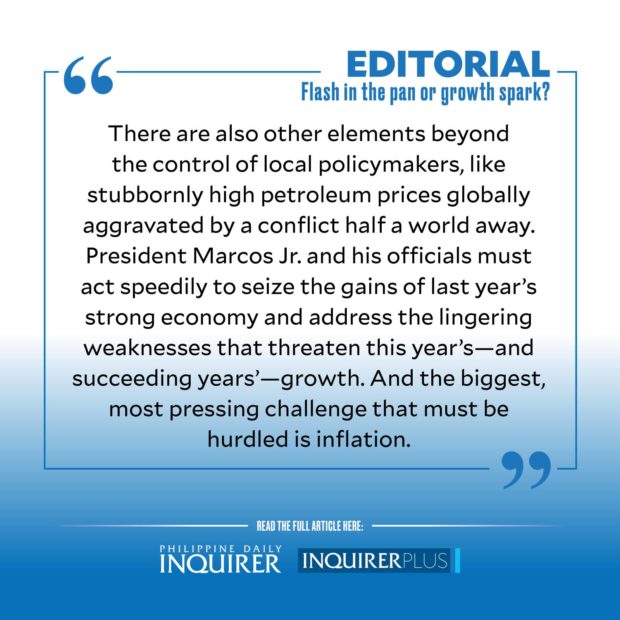
According to the government, the country’s gross domestic product (GDP)—the total value of economic output during a given period—expanded by 7.6 percent in 2022, as the relaxation of mobility restrictions encouraged Filipinos to buy more, consume more, and travel more, among other activities that were severely constrained in previous years.
And, as it always does in this country, the massive resources brought to bear by candidates every election year helped pump prime the economy during one of the most hotly contested polls in recent history.
Add to that the so-called base effect where any improvement in a succeeding period stands out in contrast with the poor performance of a preceding period (such as the weaker economic data seen during the worst of the COVID-19 crisis), and we have what was revealed last week: impressive numbers.
Sadly, impressive numbers that should otherwise make Filipinos excited about prospects of better lives for them are being drowned out by equally superlative negative figures, which are more real to them in their day-to-day lives.
We are talking, of course, about the country’s inflation rate, which remains at 14-year highs. And even though it looks like price spikes of basic goods and services have peaked last December, the average citizen continues to feel the pain in his wallet whenever he or she visits the grocery or wet market to buy sugar, vegetables (especially onions), and, more recently, eggs.
There are also other elements beyond the control of local policymakers, like stubbornly high petroleum prices globally aggravated by a conflict half a world away.
President Marcos Jr. and his officials must act speedily to seize the gains of last year’s strong economy and address the lingering weaknesses that threaten this year’s—and succeeding years’—growth.
And the biggest, most pressing challenge that must be hurdled is inflation.
This can be addressed by clearing logistical bottlenecks that slow down the delivery, and consequently increase the prices, of basic food commodities.
The President should take decisive action to relieve local shortages by temporarily increasing imports where they are needed, while simultaneously investing in long-term efforts to improve local production. This is easier said than done, given the loud howls of protest that come from opposing camps of economic liberals and protectionists, but it is something that Mr. Marcos can withstand given his large, still unused stockpile of political capital.
Beyond this, the Marcos Jr. administration—after pointing at the direction that it wants the Philippines to go—must get out of the private sector’s way and allow the business sector to do what it does best: deploy resources in support of the country’s goals, free of state inefficiencies, and earning a decent profit while at it.
This is the only way that the government, with its limited resources, can address the infrastructure gap that has long prevented the country from realizing its full economic potential.
Indeed, it is only proper that the sharpest economic contraction experienced by the country since World War II be met with the sharpest economic expansion in 46 years.
But no one should rest on these laurels, not least of all the Marcos Jr. administration which now holds the reins of the country’s growth engines.
Policies to ensure a sustained economic expansion must be implemented so that Filipinos will feel and experience this growth equally and, perhaps more preferably, equitably.
Without equitable growth, our 7.6 percent GDP expansion rate—and all the impressive numbers that may follow—will remain meaningless for the majority of our countrymen who continue to struggle in their daily lives.
The bad news is that the country’s economic situation remains challenging, and we cannot borrow our way out of the current crisis because the previous administration had already borrowed from local and foreign creditors to the hilt, just beyond the threshold of what is considered prudent.
But the good news is that the Philippine economy has produced a growth spurt that can, with the proper policies, be turned into a full-fledged, multiyear growth momentum.
The rosy economic numbers of 2022 can be a flash in the pan, or it can be the spark that can turn the country into the hottest investment destination this side of the world. Which one it will be is up to us. All of us.

